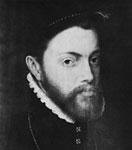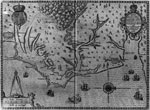Spaniards founded the first European settlements in the Southeast and Gulf Coast areas. In 1526 Lucas Vázquez de Ayllón (1475-1526) established the first Spanish colony, which he named San Miguel de Gualdape after the Guale Indians, who lived in coastal Georgia. Located near Sapelo Sound in present-day Georgia, the community did not succeed because of poor planning and difficult weather conditions.
To counter growing French interests in America, in 1559 the Spanish Crown instructed Tristán de Luna y Arrellano (d. 1573) to establish a Spanish settlement in Pensacola. Most of his ships were destroyed by a hurricane, however, and he returned to Mexico in disgrace. Several other attempts at settlement were defeated by hostile Indians or attacks by the French.
King Phillip II (May 21, 1527-September 13, 1598) was a masterful manager of Spain’s overseas empire. He commissioned Pedro Menéndez de Avilés (1519-1574) -- responsible for the security of treasure fleets returning to Spain from the Indies, to establish a colony in Florida. Menéndez de Avilés founded St. Augustine, the first permanent European settlement located on the territory of the present-day United States. Other imperial powers repeatedly destroyed the town, but the Spaniards always rebuilt it.
1. Several of the earliest Spanish attempts at settlement were defeated by hostile Indians. This document concerns the indigenous Mexican forces that took part in Tristán de Luna y Arellano’s failed expedition to Florida in 1559-62.
2. Philip II ruled Spain at the height of its imperial glory. In addition to his achievements in the New World, he was victorious over the Turks at Lepanto (1571), incorporated Portugal into Spain (1580), and ended the war with the Dutch. His greatest setback was the defeat of the Spanish Armada by the British in 1588.
3. The Spaniards explored the Atlantic coast as far north as Virginia, but did not establish settlements on the east coast further north than present-day Georgia.
4. The French initially touched the Florida coast near the St. Mary's River in the early 1560s. They attempted settlements in the region, created alliances with the various Indian settlements, but eventually were annihilated by the Spanish in 1565.
5. Pedro Menéndez de Avilés, responsible for the security of treasure fleets returning to Spain from the Indies, founded Saint Augustine in 1565.
“La Florida.” In Pintura del gobernador, alcaldes y regidores de México. Códice Osuna. [Painting of the governor, mayors and administrators of Mexico, Osuna Codex]. Sala Cervantes. National Library of Spain. (1)
Phillip II, King of Spain (during the years 1556-1598). [head-and-shoulders portrait, facing right]. Antonio Moro. [1870-1920?]. Prints and Photographs Division. Library of Congress. (2)
[Map of the coast of Virginia in 1585]. Illus. in: Admiranda narratio, fida tamen, de commodis et incolarvm ritibvs Virginiæ … [America. Pt. 1]. Theodor de Bry. 1590. Rare Book and Special Collections Division. Library of Congress. (3)
Promontory over Florida. Photoreproduction from La Floride française, scène de la vie indienne, peintes en 1564. Theodor de Bry and Charles de la Roncière. [facsimile of the 1564 original (Paris, 1928)]. Rare Book and Special Collections Division. Library of Congress. (4)
Pedro Menéndez de Avilés. Francisco de Paula Martí. [1791]. Prints and Photographs Division. Library of Congress. (5)





